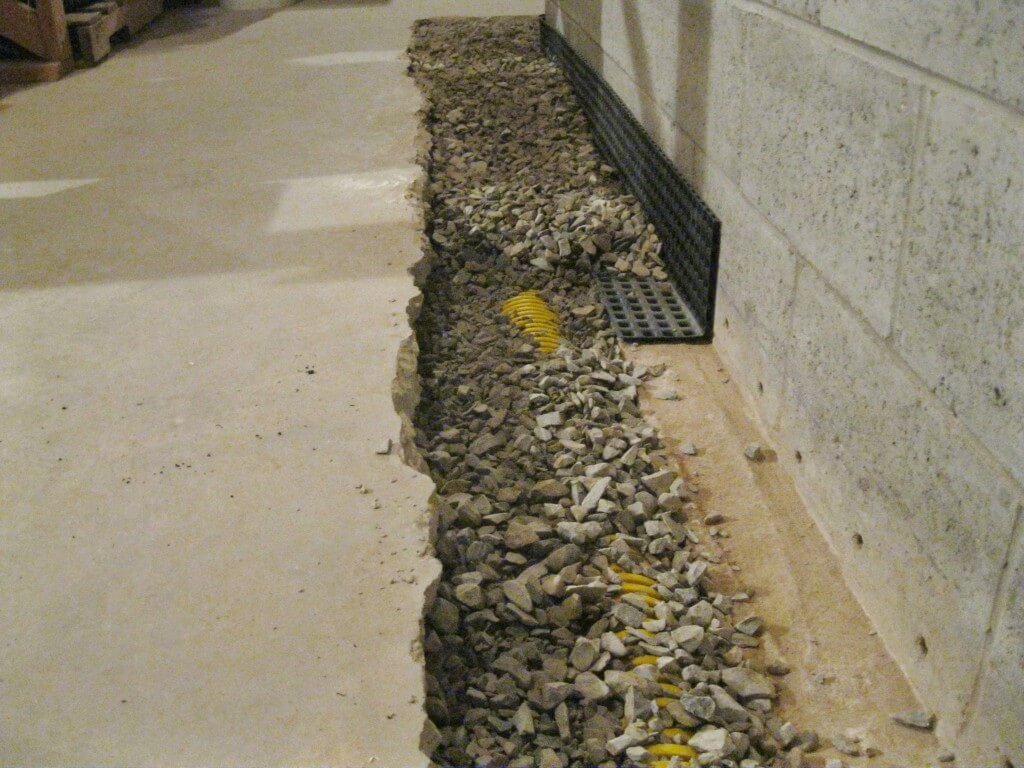Clues Your Home Needs a Portland French Drain ASAP
Clues Your Home Needs a Portland French Drain ASAP
Blog Article
The Vital Overview to Preserving Your French Drain for Resilient Performance
Preserving your French drain is vital to its effectiveness and your residential or commercial property's defense. Regular checks can save you from expensive fixings and water damages. You'll wish to know what signs to seek and how commonly to inspect your system. And also, comprehending the cleansing procedure can make a considerable difference. Let's discover the vital steps for ensuring your drain works well for several years ahead.
Understanding the Feature of a French Drain
A French drainpipe is a vital part in managing water around your home. It directs excess water away from your foundation, stopping flooding and damage. When heavy rainfall drops, the drainpipe gathers water via a perforated pipeline buried in crushed rock. This system allows water to move easily, reducing stress on your basement walls and reducing the danger of leaks.You could wonder exactly how it works in method. As water saturates the dirt, gravity draws it toward the drainpipe. The perforated pipeline captures this water, carrying it to an assigned drain area or tornado sewage system. This process maintains your lawn dry and safeguards your home's architectural integrity.Understanding just how a French drain features is key to appreciating its relevance. By effectively carrying water away, it aids preserve a secure and dry living environment. Keeping your French drain in leading problem warranties you stay clear of expensive fixings down the line.
Routine Inspections: What to Try to find
Begin by checking for any blockages that might be blocking water circulation when you're checking your French drainpipe. Pay interest to signs of surface area disintegration around the drain, as this can suggest prospective problems. Routine assessments will help maintain your drain system functioning efficiently.
Obstructed Drainpipe Assessment
Just how can you inform if your French drain is obstructed? First, look for water merging in your lawn, especially after heavy rain. That's a red flag if you notice locations where water gathers rather of draining pipes. You must likewise inspect the drainpipe electrical outlet; if water isn't spurting as it should, there's most likely a clog. Listen for unusual gurgling audios, which can suggest trapped air. Furthermore, examine the drainpipe's surface for any type of greenery growth, as origins can infiltrate and block the system. If you scent moldy odors, it can aim to stationary water created by an obstruction. Frequently evaluating these indicators can help you keep your French drain effectively and protect against expensive repairs.
Surface Erosion Check

Cleaning Your French Drainpipe: Step-by-Step Guide
Cleansing your French drainpipe is necessary for maintaining it working effectively. You'll require some details tools and a clear procedure to ensure everything runs smoothly. Allow's stroll with the actions and tips for maintaining your drainpipe efficiently.
Tools You'll Require
To take on the job of cleansing your French drainpipe properly, you'll wish to gather a few vital devices. Get hold of a sturdy pair of gloves to protect your hands from particles and sharp objects. A tiny shovel or trowel will help you get rid of dust or obstructions around the drainpipe. For removing the interior, a plumber's snake or a high-pressure water nozzle can be extremely useful. You'll likewise need a pail for gathering any type of debris you take out. Having a garden tube on hand will certainly make it less complicated to rinse out the drainpipe and assure it's streaming efficiently. With these tools all set, you'll be set for a comprehensive cleaning session!
Cleansing Refine Actions
Beginning by reviewing the location around your French drain for any visible particles or obstructions. Get rid of fallen leaves, branches, or dirt that might block water flow. Next off, inspect the inlet and electrical outlet locations; clear any blockages to assure correct drainage. Utilize a garden hose pipe to flush the drain, routing water into the inlet. This helps displace any gathered sludge or sediment. If you see consistent obstructions, consider using a plumbing's snake to break them up. After cleaning, examine the crushed rock around the drain; replenish it if it's gotten rid of. Ultimately, validate the drainpipe covers are intact and firmly in area to stop debris from entering. Routine cleansing keeps your French drainpipe working properly.
Upkeep Regularity Tips
While routine upkeep is vital for your French drain's long life, recognizing how frequently to keep it can make all the difference. Preferably, you ought to examine your French drain a minimum of two times a year, ideally in springtime and loss. After heavy rainfall or snowmelt, check for blockages or particles. If you discover any kind of standing water, it's time to clean your drain.In areas with hefty vegetation, even more frequent upkeep-- about every three months-- might be essential. In addition, think about cleaning your French drainpipe after major storms or if you observe water pooling in your yard. By remaining positive, you'll guarantee your French drainpipe features efficiently and safeguards your residential or commercial property from water damage. Normal checks will conserve you time and cash in the lengthy run.
Determining Common Problems and Their Solutions
When you observe water merging in your lawn or damp places in your basement, it's vital to identify usual problems with your French drainpipe and implement effective solutions. One frequent problem is clogging, frequently triggered by debris like leaves or sediment. To fix this, you can utilize a plumbing serpent or a high-pressure water jet to clear blockages.Another issue may be straight from the source inappropriate incline. If your drain isn't sloped correctly, water will not move far from your home. You can adjust the incline by digging and rearranging the drain pipe.Lastly, check for damages or splits in the drainpipe itself. If you find any kind of, replacing the damaged areas is very important for peak performance. By Click This Link attending to these concerns immediately, you'll aid ensure that your French drain remains to work effectively, securing your residential property from water damages and keeping a dry, risk-free environment.
Seasonal Maintenance Tips for Your French Drainpipe
Resolving usual concerns with your French drainpipe is just the very first step in ensuring its long-lasting effectiveness. Seasonal maintenance is vital for peak performance. In the spring, eliminate leaves and particles that may have accumulated during winter. Check for any kind of obstructions in the outlet or catch basin, as water needs a clear path to stream freely.During summer season, inspect your drainpipe for any kind of signs of clearing up or changing dirt. Ensure it's still level and operating effectively. As autumn approaches, tidy out any type of dropped leaves to avoid obstructions before wintertime arrives.In winter season, watch for freezing temperature levels. If you reside in a cold climate, see to it your drainpipe isn't in danger of cold. Shielding revealed pipes can assist. Routine checks and prompt maintenance YOURURL.com can avoid costly repair services and keep your French drainpipe functioning efficiently year-round. Stay proactive and appreciate satisfaction knowing your drainage system is in great shape!
When to Employ a Professional
When to call in a professional can save you time and prevent additional damage to your French drain, recognizing. If you discover persistent standing water in your backyard, it's a clear sign that your drainpipe may be blocked or damaged. Do not disregard odd smells, as they can show sewage back-up or degeneration, which calls for immediate attention.If you locate that your drainpipe isn't functioning properly after attempts to clean or keep it, it's time to connect for specialist aid. Additionally, if you're uncertain concerning the underlying issues or lack the needed devices, working with a specialist can provide peace of mind.Finally, if your French drain is old or has experienced significant wear and tear, specialist evaluation can figure out whether repair services or full substitute is required. Trust the professionals to ensure your drain system works successfully for several years ahead.
Tips for Stopping Future Drainage Problems
To maintain your French drainpipe working efficiently, routinely examining and maintaining it can make all the difference. Start by removing particles, leaves, and dust from the surface area and drainpipe openings. This prevents obstructions that can result in water backup. Inspect the crushed rock around the drain; if it's compacted or eroded, take into consideration including fresh crushed rock to maintain optimal flow.Next, divert water far from your drainpipe by making certain rain gutters and downspouts are clear and guiding water a minimum of three feet away from your foundation. Routinely check for any kind of indications of damages or drooping. If you observe issues, resolve them immediately.Finally, consider installing a filter or a catch basin to catch bigger debris prior to it goes into the drainpipe. By staying positive with these suggestions, you'll lessen the risk of future drain issues and keep your French drain in leading form.
Regularly Asked Inquiries
How much time Does a French Drain Commonly Last?
A French drainpipe typically lasts around 30 to 40 years, relying on the products made use of and maintenance (Portland French Drain). If you stay up to date with normal checks, you can prolong its lifespan also further
Can I Install a French Drain Myself?
Yes, you can install a French drainpipe yourself if you've obtained the right devices and understanding. Simply make sure to plan carefully, comply with regional regulations, and guarantee proper drainage to prevent future concerns.
What Products Are Made Use Of in a French Drainpipe?
You'll need perforated pipe, gravel, landscape material, and a solid drain pipe for your French drainpipe. These materials aid reroute water effectively, stopping flooding and keeping your residential or commercial property risk-free and dry from water damage.

Is a License Required to Mount a French Drainpipe?
You'll likely require a permit to set up a French drainpipe, depending on regional laws. Examine with your municipality to assure you abide with any needed guidelines and stay clear of potential issues during installment.
What Are the Costs Linked With French Drainpipe Upkeep?
Keeping a French drain generally sets you back in between $100 and $500 each year. You'll require to consider expenses for cleaning, repair work, and examinations. Normal maintenance helps avoid larger warranties and expenses your system operates properly for years - Portland French Drain. When you're examining your French drainpipe, beginning by examining for any blockages that could be blocking water flow. By staying positive, you'll ensure your French drain functions successfully and safeguards your building from water damages. When you notice water pooling in your yard or damp places in your cellar, it's important to determine common problems with your French drain and implement efficient solutions. You can readjust the slope by digging and rearranging the drain pipe.Lastly, check for damage or splits in the drain itself. Inspect the gravel around the drainpipe; if it's compacted or eroded, consider including fresh gravel to keep optimal flow.Next, draw away water away from your drain by ensuring downspouts and gutters are clear and guiding water at least three feet away from your structure
Report this page